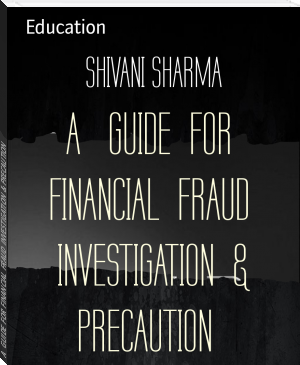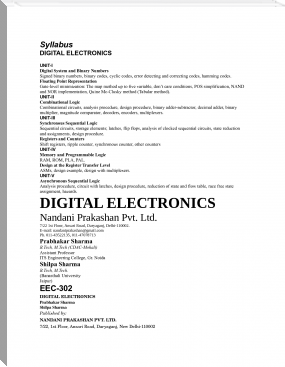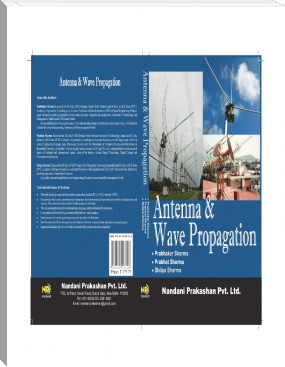A GUIDE FOR FINANCIAL FRAUD INVESTIGATION & PRECAUTION by SHIVANI SHARMA (books to read for beginners .txt) 📕

- Author: SHIVANI SHARMA
Book online «A GUIDE FOR FINANCIAL FRAUD INVESTIGATION & PRECAUTION by SHIVANI SHARMA (books to read for beginners .txt) 📕». Author SHIVANI SHARMA
AML rules and regulations rose to global recognition when the Financial Action Task Force (FATF) was formed in 1989, setting international standards for fighting money laundering. The aim of enforcement groups like the FATF is to maintain and promote the ethical and economic advantages of a legally credible and stable financial market.Since money is a limited resource, money accumulated illegally and with no regulation prevents capital from flowing into socioeconomically productive industries. The imbalance in money flow also inevitably leads to further printing of money, harming the purchasing power of a country's currency. If not controlled, this inflation can cripple and erode an economy.
3).How Anti-Money-Laundering Action Helps Reduce Overall Crime
Money-laundering investigations center on parsing financial records for inconsistencies or suspicious activity, and these financial records often tie perpetrators to criminal activity. In today's regulatory environment, extensive records are kept on just about every significant financial transaction. Therefore, when trying to uncover the identity of a criminal, few methods are more effective than locating records of financial transactions in which he or she was involved.Terrorists, organized criminals and drug smugglers rely extensively on money laundering to maintain cash flow for their illegal activities. Taking away a criminal's ability to launder money hampers the criminal operation by shutting off cash flow. Therefore, fighting money laundering is a highly effective way to reduce overall crime.
In cases of robbery, embezzlement or larceny, the funds or property uncovered during money-laundering investigations frequently are able to be returned to the victims of the crime. For example, when money that was laundered to cover up embezzlement is discovered, it can usually be traced back to the source of the embezzlement. While this does not nullify the original crime, it can put the money in question back in the proper hands and part it from the perpetrator.
4).Anti-Money-Laundering Enforcement Groups
The Financial Action Task Force sets the international standard for combating money laundering. Formed in 1989 by leaders of countries and organizations around the world, the FATF is an international body of governments that sets standards for stopping money laundering and promotes the implementation of these standards. Because laundering money is one way in which terrorists finance their activities, money laundering and terrorism go hand in hand. The FATF is, therefore, also dedicated to the setting and implementation of standards for fighting terrorist financing and other threats to the international financial system.
The FATF developed a series of recommendations that were adopted in February 2012 to give its 35 member countries and two regional organizations a comprehensive set of measures to implement in the fight against money laundering, terrorist financing and financing of the proliferation of weapons of mass destruction. The FATF promotes the implementation of these measures, but the leaders of each member country carry out the measures on a national level. Each country must adapt the measures to make them appropriate for its own circumstances. To assist members in implementing the recommended anti-money-laundering measures, the FATF provides them with guidance and best practices.
In 2000, the FATF began using a name-and-shame system that publicly announced countries that failed to produce and enforce comprehensive AML laws and had minimal to zero participation in the international crusade against illegal moneymaking activities.Another international group that participates in combating money laundering is the International Monetary Fund (IMF). With 189 member countries, the IMF has been expanding its anti-money-laundering efforts since 2000. The events of September 11, 2001 led to an intensification of the IMF's work in this area and spurred the broadening of its goals to include fighting the financing of terrorism. Shortly thereafter, the IMF began assessing the compliance of its member countries with the international standard for combating terrorist financing.
The IMF pays special attention to the effects of money laundering and terrorist financing on the economies of its member countries. The IMF points out that people who launder money and finance terrorism target countries with weak legal and institutional structures and use the weaknesses to their advantage in order to move funds. Ways in which the IMF helps its members stop money laundering and terrorist financing include serving as an international forum for the exchange of information and helping countries develop common solutions to these problems and effective policies to guard against them.
In addition, the IMF contributes to the evaluation of each country's compliance with anti-money-laundering measures and to the identification of areas where improvements are needed. The IMF focuses its work on assessing the strengths and weaknesses of each member's financial sector in complying with the FATF recommendations, providing members with the technical assistance needed to strengthen their legal and financial institutions, and offering advice to members in the process of developing policies directed toward compliance with FATF measures.
CRYPTO-CURRENCY
CRYPTO-CURRENCY
A cryptocurrency (or crypto currency) is a digital asset designed to work as a medium of exchange that uses cryptography to secure its transactions, to control the creation of additional units, and to verify the transfer of assset.Cryptocurrencies are a type of digital currencies, alternative currencies and virtual currencies. Cryptocurrencies use decentralized control as opposed to centralized electronic money and central banking systems. The decentralized control of each cryptocurrency works through a blockchain, which is a public transaction database, functioning as a distributed ledger.
Bitcoin, created in 2009, was the first decentralized cryptocurrency. Since then, numerous other cryptocurrencies have been created.These are frequently called altcoins, as a blend of alternative coin.
1) Formal definition:-According to Jan Lansky, a cryptocurrency is a system that meets all of the following six conditions:
The system does not require a central authority, distributed achieve consensus on its state.
The system keeps an overview of cryptocurrency units and their ownership.
The system defines whether new cryptocurrency units can be created. If new cryptocurrency units can be created, the system defines the circumstances of their origin and how to determine the ownership of these new units.
Ownership of cryptocurrency units can be proved exclusively cryptographically.
The system allows transactions to be performed in which ownership of the cryptographic units is changed. A transaction statement can only be issued by an entity proving the current ownership of these units.
If two different instructions for changing the ownership of the same cryptographic units are simultaneously entered, the system performs at most one of them.
In March 2018, the word "cryptocurrency" was added to the Merriam-Webster Dictionary.
2)OVERVIEW:-Decentralized cryptocurrency is produced by the entire cryptocurrency system collectively, at a rate which is defined when the system is created and which is publicly known. In centralized banking and economic systems such as the Federal Reserve System, corporate boards or governments control the supply of currency by printing units of fiat money or demanding additions to digital banking ledgers. In case of decentralized cryptocurrency, companies or governments cannot produce new units, and have not so far provided backing for other firms, banks or corporate entities which hold asset value measured in it. The underlying technical system upon which decentralized cryptocurrencies are based was created by the group or individual known as Satoshi Nakamoto.
As of September 2017, over a thousand cryptocurrency specifications exist; most are similar to and derive from the first fully implemented decentralized cryptocurrency, bitcoin. Within cryptocurrency systems the safety, integrity and balance of ledgers is maintained by a community of mutually distrustful parties referred to as miners: members of the general public using their computers to help validate and timestamp transactions, adding them to the ledger in accordance with a particular timestamping scheme.Miners have a financial incentive to maintain the security of a cryptocurrency ledger.
Most cryptocurrencies are designed to gradually decrease production of currency, placing an ultimate cap on the total amount of currency that will ever be in circulation, mimicking precious metals. Compared with ordinary currencies held by financial institutions or kept as cash on hand, cryptocurrencies can be more difficult for seizure by law enforcement.This difficulty is derived from leveraging cryptographic technologies.
3)Architecture
A))Blockchain:-The validity of each cryptocurrency's coins is provided by a blockchain. A blockchain is a continuously growing list of records, called blocks, which are linked and secured using cryptography.[14][17] Each block typically contains a hash pointer as a link to a previous block, a timestamp and transaction data.By design, blockchains are inherently resistant to modification of the data. It is "an open, distributed ledger that can record transactions between two parties efficiently and in a verifiable and permanent way".For use as a distributed ledger, a blockchain is typically managed by a peer-to-peer network collectively adhering to a protocol for validating new blocks. Once recorded, the data in any given block cannot be altered retroactively without the alteration of all subsequent blocks, which requires collusion of the network majority.
Blockchains are secure by design and are an example of a distributed computing system with high Byzantine fault tolerance. Decentralized consensus has therefore been achieved with a blockchain. It solves the double spending problem without the need of a trusted authority or central server.
The block time is the average time it takes for the network to generate one extra block in the blockchain. Some blockchains create a new block as frequently as every five seconds. By the time of block completion, the included data becomes verifiable. This is practically when the money transaction takes place, so a shorter block time means faster transactions.[citation needed]Time stamping Cryptocurrencies use various timestamping schemes to avoid the need for a trusted third party to timestamp transactions added to the blockchain ledger.
B)Proof-of-work scheme:-The first timestamping scheme invented was the proof-of-work scheme. The most widely used proof-of-work schemes are based on SHA-256 and scrypt. The latter now dominates over the world of cryptocurrencies, with at least 480 confirmed implementations.Some other hashing algorithms that are used for proof-of-work include CryptoNight, Blake, SHA-3, and X11.
Proof-of-stake and combined schemes
Some cryptocurrencies use a combined proof-of-work/proof-of-stake scheme. The proof-of-stake is a method of securing a cryptocurrency network and achieving distributed consensus





Comments (0)